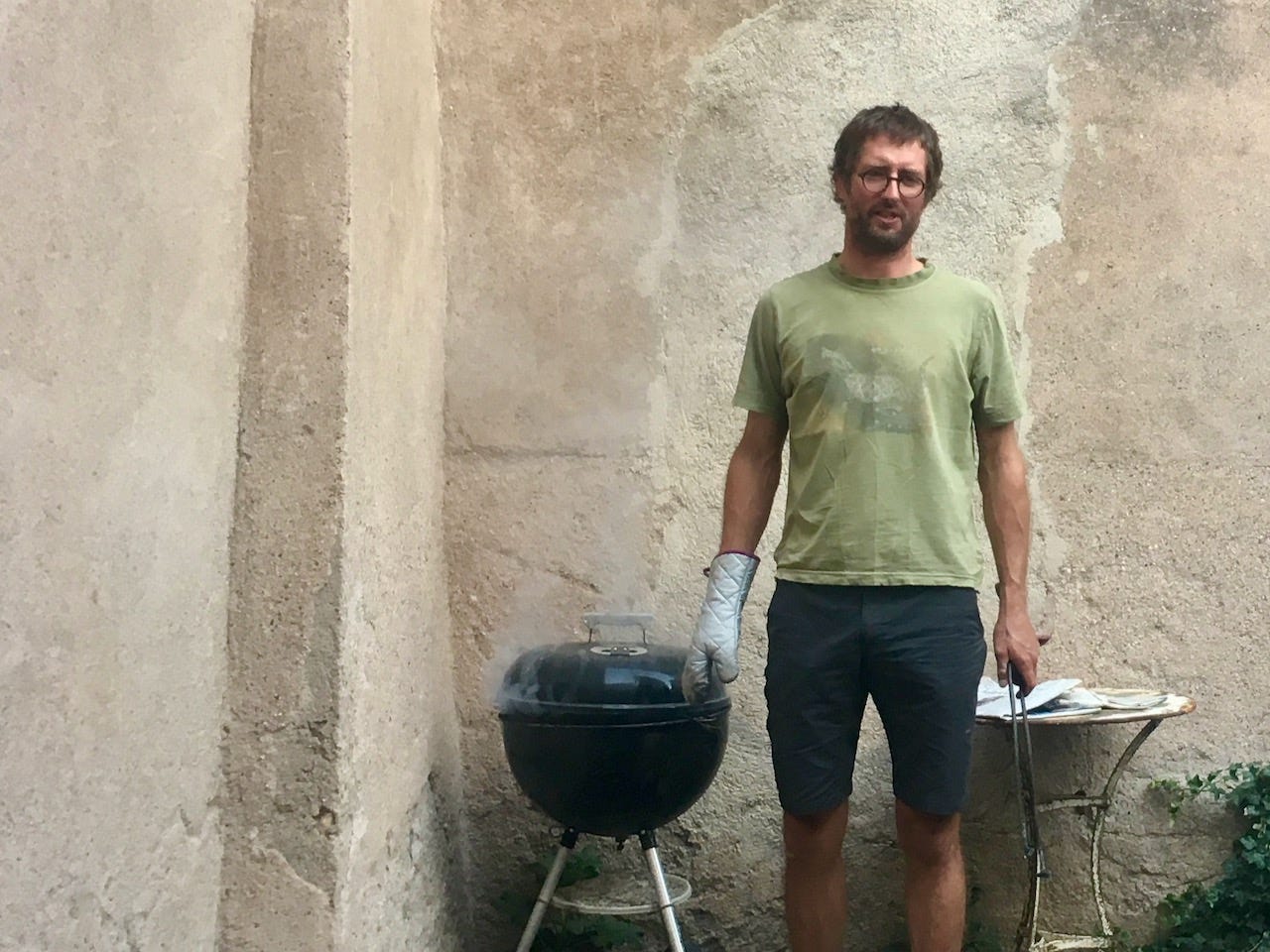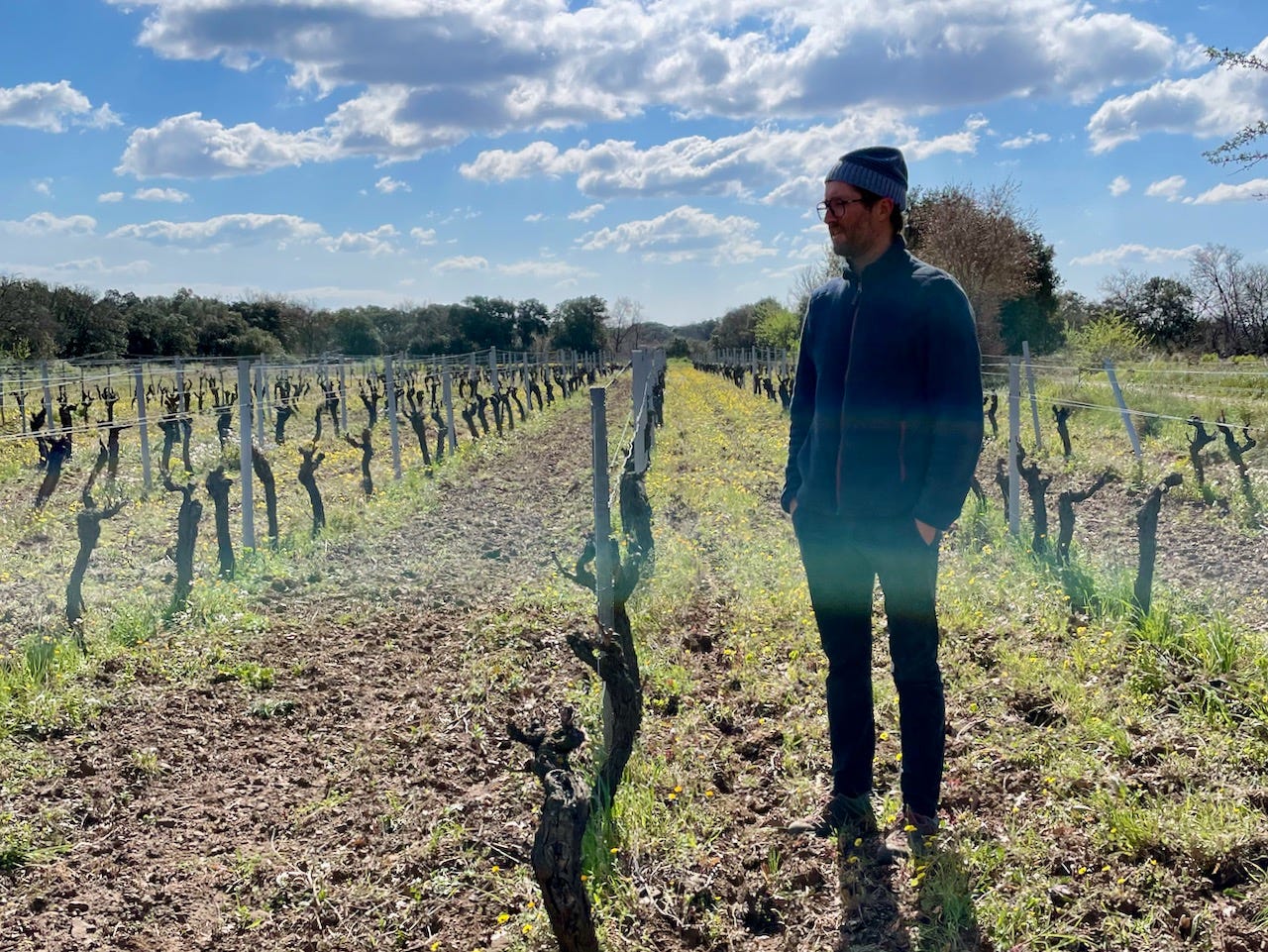The Languedoc Recipe
And how to forget it. British-born Hérault vigneron Joe Jefferies on overcoming the entrenched stereotypes of Languedoc winemaking.
Originally from Warwickshire, Joe Jefferies moved to the Languedoc in 2003. There he met his wife, Amandine, whose father hobby-farmed a small surface of grenache and grenache blanc on the ancient lava flow near Caux. By the early 2010s, Jefferies had become a vigneron, thanks to the encouragement of friends like Remi Poujol and Bernard Bellahsen. Today he farms 4ha around Caux, producing wines with neither sulfite addition nor filtration.
For this guest essay, I invited Jefferies to share his unusual outsider’s experience of the challenges facing Languedoc winemakers of his generation. He identifies the region’s broad stylistic inertia - and how he got past it. - Aaron
BEING SERIOUS
My wife Amandine and I started to make wine in earnest in 2013 in the village of Caux in the Hérault. We already drank natural wines, thanks to local friends like Rémi and Cathy Poujol, and Cécile and Bernard Bellahsen, who had made the bread for our wedding in 2009. Natural wines were the wines we loved, the wines we wanted to make.
As an English winemaker in the Languedoc, I certainly have no family winemaking heritage to uphold. Vineyards here are relatively affordable, so the financial implications of taking risks are relatively contained both in terms of agriculture and winemaking (unlike, say, for a château in Bordeaux). This lack of pressure means that, in theory at least, it's an easier step to farm organically and make wine without additives.
But I also wanted my winemaking venture to be a success. Romantic as the idea may be, making wine was my attempt to provide for my new family. I felt I had to be serious and limit risk ! So that first year I employed the services of an oenologist to provide technical pointers and to be a sounding board for my ideas.
A CERTAIN RECIPE
From international wine buyers to my own family members, the idea of how a Languedoc wine should be – especially a red – was more or less fixed, when we started out. There was a direct correlation between the ripeness and extraction of a wine and how seriously it was taken. Lighter, easier drinking wines were Vins de Pays. Languedoc appellation wines were big. A “quality” appellation red should have ripe, rounded tannins and stewed fruit aromatics. It should have extraction and colour, and possibly some barrel aging.
The majority of the Languedoc's flagship artisanal-organic wine domaines - the ones that over the past forty years have established the Languedoc's credentials as a region where “quality” wine can be made - make red wines of this type. (In passing, these wines are the antithesis of the high yield, low alcohol, aqueous table wine historically associated with the Languedoc, as if made in reaction to this shameful past…)
My œnologist was dead set on pointing me in this direction. But I soon realised this wine profile requires a certain recipe.
For reds, it means waiting until the grapes have reached an advanced stage of phenolic ripeness (i.e. overripeness) before harvest, by which point the tannins in the skins, seeds and stems have rounded out. It also means the aforementioned jammy aromatics and often very high levels of potential alcohol, especially with early ripening varieties like grenache, which can reach a potential alcohol of 16% or more when phenologically ripe.
The oenologist's answer to the potential alcohol problem? Whack some water in to bring sugar levels down! Then correct acidity if need be, with the addition of tartaric acid.
The secret for a Languedoc white? Preserve freshness by blocking the malolactic fermentation! The logic this time? Malic acid is more tart than the lactic acid created by the malolactic fermentation, so they seek to preserve it at all costs. The oenological technique? A goodly dose of sulfites in the initial juice to kill lactic bacteria. Then, after alcoholic fermentation has finished, another heavy dose of SO2 for good measure, and probably filtration to boot.
This approach was a non-starter for me. I discovered I had a visceral aversion to putting anything in my wines, be it water, sulfites or anything else. I also found the aromatics of these reds uninteresting. And I felt white wines that haven't been through their malo lack elegance.
A DIFFERENT PATH
Putting these prickly questions aside, I asked the œnologist if he could advise on a purely technical level, given the different path I had chosen. But – as Bernard Bellahsen had pointed out to me early on – another basic problem with oenologists is they don't often know what happens when you don't add sulfites, because they invariably do add them.
A stand-off with my œnologist ensued. He systematically advised me to sulfite my wines and I systematically refused. I think this was his standard go-to advice. But I also suspect he was looking to avoid litigation by keeping a hard copy of our communication when things (necessarily, in his mind) went pear-shaped.
He needn't have bothered : the wines turned out just fine and I didn't take him to court. In hindsight, I should have taken Rémi Poujol's initial advice to le botter en touche - a French rugby metaphor meaning “to dodge the subject” - whenever the oenologist made suggestions.
A POOL OF EXPERIENCE
This oenological parenthesis lasted one season. Since then, I have pooled my experience in a loose collegial way with Bernard, Rémi, Julien Peyras and Antony Tortul (among others) and learnt much more in the process.
In retrospect, it seems off-kilter somehow that the late harvest and relatively long maceration times of these big, structured Languedoc reds play such a major part in forming this Languedoc identity, over and above, say, the type of soil found in a particular vineyard.
Yet, while I didn't go down the overripe grapes and water route described above, I did unthinkingly interiorise the idea of the Languedoc red as a wine with body, colour, and supple structure. In the beginning, I applied a winemaking style necessary to make this type of wine.
The trick, or so I initially thought, was to pick as late as possible without letting potential alcohol stray beyond reasonable limits. I tempered the higher sugar levels of our earlier ripening grenache by blending it with later ripening carignan, itself ripe at lower potential alcohol. Grapes were then destemmed (to remove the stems' tannins from the equation) then macerated in tank for about a month with regular pressing down and pumpovers.
The resulting wines conformed to the classic Languedoc style in terms of their weight, their opulence and the quality of their tannins. But – though I couldn't exactly put my finger on it – I had a lurking feeling that I was missing something important.
I subsequently realised that this fixation on style was white noise that stopped me from tuning in to my particular terroir, stopped me from winkling out the right way to work with the terroir rather than superimposing something onto it.
I needed to discover the elusive alchemy between farming choices in the vineyard, grape variety, picking date, type of vinification, soil type (etc!) to create a balanced wine that actually expresses where it's from. Through experimentation, I later found that the salty minerality of our basalt soils is expressed more clearly with a shorter maceration. The texture of this minerality itself is enough, in terms of architecture. Today I find the tannins of my earlier reds were cluttering the profile, particularly when the wines were young.
BEYOND LANGUEDOC TYPICITY
In regions like Burgundy or the Beaujolais, this kind of experimentation has largely already been done. Winemakers working in these regions today are standing on the shoulders of giants and any individual winemaking decisions are coming at the sharp end of the process. The what, the where, and the how have already been resolved with a particular sensitivity given to each terroir. In this respect, the Languedoc is clearly at an earlier stage in its evolution.
Today, Languedoc appellation tasters - like tasters in appellations throughout France - look for a notion of typicity when bestowing or denying the appellation, part of an ongoing push to establish and maintain a clear regional identity.
It's a blanket, region-wide approach that isn't necessarily sensible even in regions with relatively homogeneous terroir profiles. It is particularly ill-adapted to the plethora of different terroirs found in the Languedoc, which range from clay and limestone, to shale, to Villafranchian rolled stones or our own basalt soils within just a few kilometres of Caux.
I don't think it's a coincidence that the same winegrowers who have questioned conventional agriculture and the use of additives in winemaking have also questioned this outdated notion of Languedoc typicity.
These wine growers have plowed their own furrows, thinking and learning the while, often making wines which are dubbed “atypical.” Atypical as they might be when compared to the classic Languedoc style, these are the wines that – critically – tend to better reflect their specific place within the diversity of Languedoc terroirs.
FIN
Joe Jefferies - Les Bories Jefferies
21 Rue de la Foire
34720 CAUX
FURTHER READING
A Grand Cru of the Hérault - A 2021 visit to the parcel that yields Jefferies’ “Pierre de Sisyphe”
More Paysan Than Vigneron: Fontedicto - A 2021 interview with Bernard Bellahsen.
Carignan and Patience: Le Temps Fait Tout - A 2021 interview with Rémi Poujol.





Great work Joe, I've been tasting and drinking your wines from almost the beginning and they get better and better. Definitely getting more feeling of your vineyards and soils. Enjoyed the article, must catch up next time I'm down.